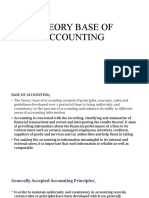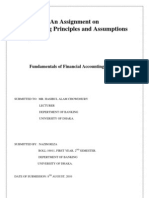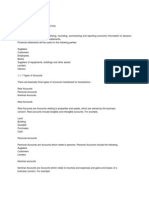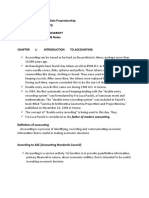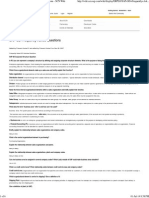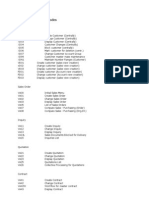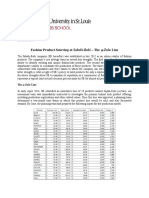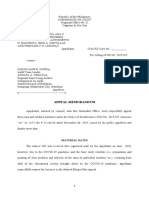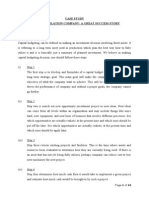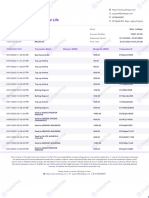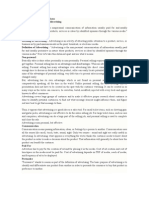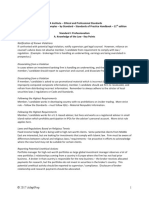SANJEEV GIRI
Accounting Principles & Assumptions
Fundamental Accounting Assumptions or Concepts
Fundamental Accounting Assumptions or Concepts are the assumptions which are presumed to have
been followed in preparing the annual the accounts. The entities which do not follow any of the
fundamental accounting assumptions are required to disclose which of these assumptions have not
been followed and the reasons for not following them. The Fundamental Accounting Assumptions
are:
1. Going Concern Assumptions
This Concept assumes that every business has a long indefinite life. Since financial
statements are prepared on the basis of this concept, all fixed assets are shown in the books
at their cost ignoring their market value.
2. Consistency Assumptions
This principle requires that accounting practices, methods and techniques used by a
business unit should be Consistent. A business unit can adopt any accounting practice, but
once a particular practice is chosen, it must be used for a number or years.
3. Accrual Assumptions
According to the Accrual Assumption, a transaction is recorded in the books of accounts at
the time when it is entered into and not when the settlement takes place. Thus, revenue is
recognised when it is realised, i. e., when sale is complete or services are rendered; it is
immaterial whether cash is received or not. Similarly, expenses are recognised as expenses
in the accounting period in which the revenue related to it is recognised, whether paid in
cash or not.
Accounting Principles
1. Business Entity Concept/Accounting Entity
This concept considers a business unit as a separate entity. Business and businessman
are two separate entities and all the business transactions are recorded in the books of
accounts from business point of view.
2. Money Measurement Concept
According to this concept only those transactions are recorded in the books of accounts
which can be expressed in monetary terms. The non-financial transactions do not find
any place in the accounting records. Money is the common denominator to denote the
value of the various assets of diverse nature to give a meaningful total of these assets.
3. Accounting Period Concept
According to this concept the long life of business is divided into justifiable accounting
periods so as to help businessman to know the result of this period depends on the
nature of business. Accounting period may be either a calendar year (From January 1 to
December 31) or the financial year of the Govt. (April 1 to march 31)
CONTACT 8860705297
�SANJEEV GIRI
4. Full Disclosure Principle
This concept implies that financial statements should disclose all material information
which is required by the proprietor and other users to assess the final accounts of the
business unit.
5. Materiality Principle
This principle emphasizes that only those transactions should be recorded which are
material or relevant for the determination of income from the business. All immaterial
facts should be ignored.
6. Conservatism or Prudence principle
This principle is nothing but a formal expression of the maxim ‘’Anticipate no profits and
provide for all possible losses.’’ In other words, it considers all possible losses but
ignores all possible profits
7. Cost concept/Historical cost Principle
According to this concept all fixed assets are recorded in the books at cost i.e. the price
paid to acquire them. Any subsequent increase or decrease in their value will not be
shown in the records except the depreciation of these assets. In subsequent years,
therefore fixed assets are shown at cost less depreciation provided on them up to date.
Continuous charging of depreciation on the assets will ultimately eliminate the assets
from the books
8. Matching Principle
This concept states that it is necessary to charge all the expenses incurred to earn
revenue during the accounting period against that revenue in order to ascertain the net
income or trading results of the business. The matching concept which is so closely
related to accrual concept and accounting period concept helps a businessman in
realizing his objective i.e. in ascertaining the trading result or profit or loss from the
business. For ascertaining the net income.
Income = Revenue – Expenses
9. Dual Aspect Principle
This Concept also know as equivalence concept signifies that every business transaction
has two fold effects or every transaction affects at least at two accounts. This concept is,
in fact, the base on which Double Entry system of Book-Keeping is based. According to
this principle, every debit has a corresponding credit.
10. Realisation Principle
According to this concept income is treated as being earned on the date on which it is
realized i.e. the date on which goods or services are transferred to the customers. Since
this exchange of goods or services may be for cash or on credit, it is not important
whether cash has actually been received or not.
CONTACT 8860705297
�SANJEEV GIRI
Accounting Standards
History and Development of Accounting Standards
The International Accounting Standards Committee {IACS} came into existence on 29th
June 1937. The main objective of IACS are to develop the accounting standards. In India
the Institute of Charted Accountants of India {ICAI} had constituted the ‘Accounting
Standards Board’ in April 1977 for developing the Accounting Standards.
Meaning of Accounting Standards
Accounting standards are the rules in written from that ensure the uniformity of
Accounting Standards, and provide guidance for the preparation, presentation and
reporting of accounting information.
Features/Characteristic/Nature of Accounting Standards
a) Provide Guidance to the Accountants ;
b) Brings Uniformity ;
c) Accounting Standards are flexible ;
d) Provide information
Advantages of Accounting Standards a) Helpful in bringing the uniformity b) Helpful
in improving the reliability of financial statements c) Helpful in resolving the conflicts
among the users of financial information.
Accounting Standards issued by the ICAI : Amendment is made recently in the section
211 of companies act 2013. According to this amendment, the financial statements
(Profit and Loss Account and Balance Sheet) of company should comply with Accounting
Standards. The Council of the Institute of Charted Accountants of India has so far issued
the following 32 Accounting Standards (AS).
CONTACT 8860705297
�SANJEEV GIRI
Source Documents
Source of Documents
All financial transactions are recorded in the books of accounts on the basis of source document or
on the basis of some evidence. Source documents are helpful to prove that a transaction is actually
made or not.
Cash memo : Cash memo is A bill of sale it is a written document by a ‘seller’ to a purchaser,
reporting that on a specific date, a particular sum of money or other ‘’Value received’’,
Invoice or Bill : When goods are sold on credit, An invoice or bill is issued on the name of the buyer,
indicating the products, quantities, and agreed prices for products or services. The seller has provide
the buyer.
Receipt : A receipt is a written acknowledgment that a specified a sum of money has been received
from the customer as an exchange for goods or services. The receipt is evidence of purchase of the
goods or service.
Pay-in-Slip : Pay in slip is a form that is filled when the money is deposited by a customer in to his
bank account.
Cheque : A cheque is document (usually a piece of paper) that orders a payments of money. The
person writing the cheque, the drawer, usually has a account where the money is deposited.
Debit Note : when we return goods back to the supplier, a debit not made on the name of supplier,
it means his account his debited. Debit Note proves that a entry has been made to a debtor’s or
Creditor’s account.
Credit note : when we receive goods back from our customer, then a credit not is made on the name
of the customer, it means customer’s account is credited.
Meaning of Voucher : Voucher is the documentary proof or evidence in support of a transaction.
For example when we purchase goods for cash, we get cash memo, and when we purchase goods on
credit, we get an invoice, when we make payment we get Receipt.
Types of Accounting Vouchers
There are two types of vouchers a) Cash Voucher B) Non Cash Vouchers
Cash Vouchers : Cash vouchers are prepared for cash transactions only, when cash is received or
paid. There are two types of cash Vouchers; a) Debit Vouchers b) Credit Vouchers
Debit Vouchers : Debit vouchers are prepared only for cash payments.
Credit Vouchers : Credit vouchers are the opposite side of debit vouchers, credit vouchers are
prepared when we receive cash
Preparation of accounting vouchers: All business transactions recorded in the books of accounts
can be compared with the source documents. Accounts are debited or credited on the basis of these
CONTACT 8860705297
�SANJEEV GIRI
source documents. After deciding, that what to be debited or credited, the next step is the
preparation of the vouchers.
Meaning of Accounting Equation
The Accounting Equation’ is based on the double-entry book keeping system. For every debit there
must be a credit. The accounting Equation states that the sum of the Total assets must be equal to
the liabilities.
Assets= Liabilities+ Capital
CONTACT 8860705297

